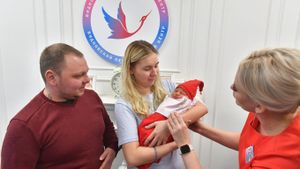The recent spread of the Highly Pathogenic Avian Influenza (HPAI) A(H5N1) virus among dairy cattle has raised significant public health concerns, highlighting the urgent need for effective vaccination strategies. A new study has evaluated the immune response and milk antibody transfer from calves and lactation cows vaccinated with varying doses of the H5 avian influenza vaccine, underscoring the importance of optimizing vaccine dosages.
The small-scale study, conducted at the Central Laboratory for Evaluation of Veterinary Biologics, involved 22 calves and lactation cows to assess the vaccine's efficiency following the alarming emergence of HPAI A(H5N1), Clade 2.3.4.4b, which was first detected in North America back in 2021. This virus poses risks not only to birds but also to cattle and, potentially, to humans.
Researchers administered different dosages of the H5 influenza vaccine to the calves and measured the humoral immune response using the Hemagglutination inhibition (HI) test and the enzyme-linked immunosorbent assay (ELISA). Results indicated clear dose-dependent immunity, with vaccinations yielding higher antibody levels at increased doses. Groups of calves receiving 4, 6, and 12 field doses (2 ml, 3 ml, and 6 ml) achieved peak antibody titers significantly higher than those receiving just 2 ml doses.
By the fourth week post-vaccination, the higher dose groups recorded HI titers peaking at 8, 9, and 9 log2, respectively, showcasing the vaccine's capability to invoke strong immune responses. Importantly, even lower doses managed to elicit responses within the protective antibody range, which is typically suggested to be above 5 log2.
Antibody transfer through milk was another focal point of study, with three lactation cows vaccinated four weeks after the calves. The findings revealed the milk antibodies emerged strongly as early as two weeks post-vaccination, showing effective transfer from the cow to the milk. Interestingly, the ELISA test demonstrated higher sensitivity for detecting antibodies present in milk than those found in serum.
"The presence of antibodies within milk is pivotal for calf immunity, as it provides protection from viruses during early life stages," stated one of the researchers. This highlights the potential for employing the H5 vaccine not only to protect adult cows but also to safeguard newborn calves through milk.
The safety evaluations during the study indicated minimal adverse effects, with only mild localized inflammation observed at higher dosage sites, signifying the vaccine's overall safety for cattle. Post-vaccination observations showed unaffected milk production and normal behavior across the vaccinated groups.
The need for effective vaccination strategies is pressing as cases of HPAI A(H5N1) have been documented across livestock, raising the potential for transmission to humans. The current U.S. assessment of HPAI presents low risk to the general public, but those with frequent exposure to infected animals face heightened risks of zoonotic infections.
Looking forward, the researchers advocate for additional studies to refine vaccination approaches, including optimizing dosages and exploring different vaccine formulations. “Ongoing investigations should focus on how varying vaccine components can affect immune response and longevity,” suggested the authors.
The study contributes valuable knowledge to the field of veterinary immunology and informs future strategies directed at preventing HPAI outbreaks and safeguarding both animal and human health against this persistent threat.



